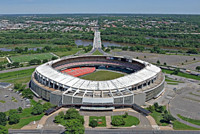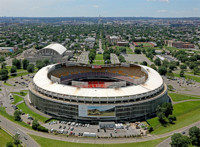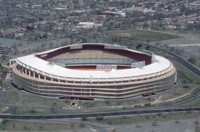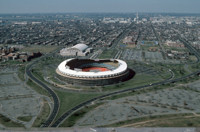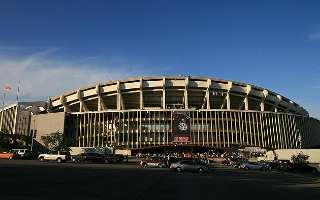RFK Stadium – until 2022
| Capacity | 46 000 |
|---|---|
| Country | United States of America |
| City | Washington |
| Clubs | Washington Redskins, Washington Senators, DC United |
| Retire year | 2022 |
| Other names | District of Columbia Stadium (1961–1969) |
| Full name | Robert F. Kennedy Memorial Stadium |
| Inauguration | 01.10.1961 (Washington Redskins – New York Giants, NFL) |
| Construction | 1960–1962 |
| Cost | $24 M |
| Design | George Leighton Dahl, Architects and Engineers, Inc. |
| Contractor | McCloskey and Co. |
| Address | 2400 East Capitol Street SE, Washington, DC 20003 |
Advertisement
RFK Stadium – historical stadium description
What was RFK Stadium like in brief?
The idea of building a large stadium in Washington had been maturing for decades. Instead of the initially planned national stadium, which could have hosted the Olympic Games, a more practical option was chosen – a venue designed for the capital’s leading baseball and football teams.
Since the fields for the two sports differ greatly, designers opted for an innovative hybrid concept with a movable lower stand section that allowed the seating configuration to be changed. The structure was enclosed in a tall, circular reinforced-concrete bowl.
The stadium was built in the early 1960s, and its pioneering design was soon replicated in other U.S. cities. The characteristic circular shape of such facilities earned them the nickname “cookie-cutter stadiums.”
The venue was located along the same axis as the Lincoln Memorial, Washington Monument, and the Capitol, although at some distance from them. Initially it was named District of Columbia Stadium (DC Stadium for short). In 1969 it was renamed in honor of Senator Robert F. Kennedy (RFK), who had been assassinated a year earlier.
The team most closely associated with RFK Stadium was the Washington Redskins (now Commanders) of the NFL. The team played 36 seasons there before moving in 1997 to a new suburban stadium.
It was a very successful period for the Redskins, who won three Super Bowls while based at RFK Stadium. The team was supported by loud, passionate fans who packed the stands to capacity – their jumping and cheering made the entire structure literally shake.
Baseball fans were less fortunate. Even before the stadium opened, the Washington Senators relocated to Minneapolis. A replacement team – also called the Senators – was quickly created, but after ten seasons it also moved to another city.
In the 1990s the stadium’s role in hosting soccer events grew significantly – to the point that RFK became one of the most important soccer venues in the United States.
RFK Stadium was one of the venues for the 1994 FIFA World Cup, the 2003 Women’s World Cup, and the football tournament of the 1996 Atlanta Olympic Games. The U.S. national team played more matches there than at any other stadium in the country.
From 1996, RFK Stadium was home to D.C. United, a founding member of Major League Soccer. At the same time, the Redskins had left the venue, and D.C. United’s presence extended the stadium’s life by another two decades.
RFK Stadium also hosted concerts featuring world-famous artists, as well as numerous other sporting, cultural, and religious events.
After D.C. United moved to the new Audi Field following the 2017 season, the stadium was left without a regular tenant. For two more years it hosted various events, but eventually the decision was made to close and demolish it.
Dismantling began in 2022, initially without removing the main structural elements. Demolition work intensified in early 2025, and the complete removal of the stadium is scheduled to be finished in the fall of 2026.
Plans are already in place to build a new stadium on the site of RFK Stadium, dedicated to the Washington Commanders. According to preliminary assumptions, the new venue is expected to be built between 2027 and 2030, with a capacity of about 65,000 spectators.
How was RFK Stadium created?
What were the initial plans for a new large stadium in Washington?
The idea of building a stadium on the west bank of the Anacostia River, aligned with the Capitol and the Washington Monument, emerged in the early 1930s. Early plans called for a national stadium on this site, which could also serve as the main venue for the Olympic Games.
The first design, created in 1932 by Allied Architects, envisioned a layout reminiscent of the later Maifeld next to Berlin’s Olympic Stadium – a large meadow flanked on three sides by stands. In front of the main stand, a field with a track was planned, where most sporting events would take place.
The idea of a national stadium in Washington had existed for at least several years by then. In 1916, Congressman George Hulbert proposed building such a facility, with the 1920 Olympic Games in mind. The stadium was planned to hold 50,000 spectators and to be located in East Potomac Park.
What were the first steps toward building a new stadium in Washington?
In 1939, a new stadium model was presented, and in 1941 the National Capital Planning Commission began acquiring land opposite the newly built DC Armory.
At the end of 1944, Congress established a nine-member National Memorial Stadium Commission. The commission produced a report recommending the construction of a 100,000-seat stadium for the 1948 Olympic Games; however, funding could not be secured.
Between 1953 and 1955, the Whitney Young Memorial Bridge (known until 1974 as the East Capitol Street Bridge) was built over the Anacostia River and Kingman Lake, extending East Capitol Street eastward.
On the west bank, the road leading to the bridge widened into an elliptical space intended as a parade ground – though ultimately, this is where the new stadium was constructed.
How did RFK Stadium come about?
In 1954, Congressman Charles R. Howell proposed building another stadium capable of hosting the Olympic Games. At his initiative, in 1956 the National Capital Planning Commission published a report assessing a potential site for the arena.
On September 7, 1957, Congress passed the District of Columbia Stadium Act, which regulated many aspects of the planned construction. The act was signed into law by President Eisenhower on July 29, 1958.
Ultimately, the stadium was not built for the Olympics, but as a multi-purpose venue serving primarily two professional Washington teams – the football Washington Redskins (NFL) and the baseball Washington Senators (MLB), both of which had previously played at Griffith Stadium.
On December 12, 1958, federal authorities leased the land where the new stadium would be built to the municipal DC Armory Board. The first lease agreement was for a period of 30 years.
Who designed RFK Stadium?
The task of designing the stadium was given to George Dahl, who developed a rather pioneering plan for a hybrid stadium with tall, circular stands – a design later referred to as the “cookie-cutter” style.
The project was created in collaboration with Osborn Engineering and Ewin Engineering Associates, responsible for the structural and engineering aspects of the stadium.
Who built RFK Stadium?
Management of the stadium during construction and after its opening was entrusted to the DC Armory Board, a special municipal body previously established to oversee the nearby DC Armory. The main contractor for the new stadium was McCloskey and Co.
When was RFK Stadium built?
The groundbreaking ceremony took place on July 8, 1960. The stadium was ready for its first football game just 15 months later, although construction was fully completed in spring 1962, when baseball games could also be held there.
How much did RFK Stadium cost?
The initial cost of construction was estimated at around $6 million, but the final expense amounted to roughly $24 million – four times the original estimate. Financing was primarily based on the issuance of bonds by the DC Armory Board, with additional funds coming from federal allocations for the development of the District of Columbia.
When was RFK Stadium inaugurated?
When was the first game held at RFK Stadium?
The first event at the new stadium was an NFL game between the Washington Redskins and the New York Giants on October 1, 1961. The match was attended by 36,767 spectators, including President John F. Kennedy, and ended with a 24–21 victory for the Giants.
When was the official dedication ceremony of RFK Stadium?
Although the NFL game marked the stadium’s practical opening, the event officially designated as the “Dedication Game” took place on October 7, 1961. The match featured teams from George Washington University and the Virginia Military Institute, with GWU winning 30–6.
When was the first baseball game held at RFK Stadium?
During construction, local baseball fans faced a disappointing situation: the owner of the MLB Washington Senators, a team that had played in the city since 1901, decided to relocate the franchise to Minneapolis, where it began play in 1961 as the Minnesota Twins.
However, a new team in Washington was quickly established, which, like its predecessor, took the name Senators and joined MLB in the 1961 season. Since the new stadium was not yet fully ready to host baseball games, the team played its first season at the old Griffith Stadium.
The Senators’ first game at the new stadium took place on April 9, 1962, again with President John F. Kennedy, who performed the ceremonial first pitch. In their inaugural match, the Senators defeated the Detroit Tigers 4–1.
What events took place at RFK Stadium?
The stadium was built as a hybrid facility to host both American football and baseball games. The main team associated with RFK Stadium was the Washington Redskins (known since 2022 as the Commanders) of the NFL.
The Redskins spent 36 seasons at RFK Stadium before moving to a new stadium in the suburbs in 1997. During that period, the team won the Super Bowl three times.
While accommodating the football team was straightforward, there were problems with the baseball team from the start. The stadium was originally intended for the Washington Senators, who relocated to Minneapolis before the stadium opened. A new team, also named the Senators, was quickly established to take part in MLB.
The “new” Senators played at the stadium for only ten seasons before also relocating to another city.
MLB returned temporarily from 2005 to 2007, when the Montreal Expos moved to Washington and became the Washington Nationals, but their stay at RFK Stadium was short-term, until their new ballpark opened. The stadium’s potential as a baseball venue therefore remained largely underutilized.
In the 1990s, RFK Stadium gained prominence as a soccer venue, to the point that it became one of the most important stadiums for the sport in the United States.
It hosted matches during the 1994 FIFA World Cup, the 2003 Women’s World Cup, and the soccer tournament at the 1996 Atlanta Olympics.
From 1996, the stadium became home to DC United, a team in the newly formed MLS. At the same time, the Redskins left RFK Stadium, and the presence of DC United extended the stadium’s active life by another two decades.
RFK Stadium also hosted other major soccer events, with the United States national team playing more matches there than at any other stadium.
In addition, the stadium held concerts featuring international music stars as well as numerous other sporting, cultural, and religious events.
Which teams played at RFK Stadium?
Washington Redskins (NFL)
The main team associated with RFK Stadium was the Washington Redskins, an NFL team. The stadium’s inaugural game featured the Redskins, and the team continued to play at RFK Stadium until 1996, spending a total of 36 seasons there.
The team was founded in 1932 in Boston and relocated to Washington in 1937. Its colors are burgundy and gold, which were eventually reflected in the stadium’s seats. During their time at RFK Stadium, the Redskins won the NFC championship five times and triumphed in the Super Bowl three times – in the 1982, 1987, and 1991 seasons.
During this period, the Redskins’ rivalry with the Dallas Cowboys developed, regarded as one of the most intense and prestigious rivalries in the NFL. Redskins fans were known for their high attendance, passionate support, loud chants, and jumping in the stands, which sometimes caused the stadium structure to sway.
From the mid-1980s, the Redskins sought to build a new stadium. The initial plan was to construct it next to RFK Stadium, but when that plan fell through, attention shifted to the suburbs. The new stadium was eventually built in Landover, about seven miles east, and opened on September 14, 1997.
The team’s name, Redskins, long regarded as offensive to Native Americans, was a source of controversy. In 2020, the team officially abandoned the name and is now known as the Washington Commanders.
Washington Senators (MLB)
The second major tenant of RFK Stadium was supposed to be the baseball team Washington Senators – hence the stadium’s hybrid design. However, during construction, the team’s owner moved the Senators to Minneapolis, where they were renamed the Minnesota Twins.
The league quickly granted a franchise for a new Washington entry, established with private investors, adding another team to MLB. It adopted the same name – the Senators.
Since the stadium was not yet fully ready in 1961, the team played its first season at the old Griffith Stadium, and only from 1962 did they begin playing at the new venue.
The Senators signed a 10-year lease for RFK Stadium. In 1971, as this period was ending, the team’s owner at the time, Bob Short, chose not to renew the lease and instead moved the team to the Dallas–Fort Worth metroplex, where they became the Texas Rangers.
During their ten seasons at RFK Stadium, the Senators did not achieve significant success, with their only winning season occurring in 1969. One notable player was power hitter Frank Howard (“Hondo”) – the seats behind the outfield that were frequently hit by his home runs were painted white to mark the landing spots.
The Senators’ final game at RFK Stadium took place on September 30, 1971, against the New York Yankees. Near the end of the game, with the home team leading 7–5, fans stormed the field, expressing their unhappiness with the team’s move. The official result was later adjusted in favor of New York (9–0).
The Senators’ departure caused financial problems for the stadium operator, forcing federal authorities to allocate additional funds to cover debts. Despite various efforts, a professional baseball team would not return to RFK Stadium for over three decades.
Washington Nationals (MLB)
After the Senators relocated to Texas, RFK Stadium was left without an MLB team for more than thirty years. A new franchise arrived only in 2005, when the Montreal Expos moved to Washington.
The Expos had been struggling for some time, and in 2002 the team was taken over by the league, which began seeking a new owner and city for the franchise. Ultimately, Washington was chosen due to its large market, baseball traditions, and the promise of a new stadium from local authorities.
Upon relocation, the Expos adopted the name Washington Nationals, the same name used by many previous Washington baseball teams.
Given plans to build a new, baseball-specific stadium, MLB’s return to RFK Stadium was only temporary. Nevertheless, an $18.5 million renovation was carried out, and the retractable seating system was reactivated after years of inactivity.
The Nationals played their first MLB game at RFK Stadium on April 15, 2005. President George W. Bush threw the ceremonial first pitch, and the home team won the opener against the Arizona Diamondbacks 5–3.
The Nationals played at RFK Stadium for three seasons (2005–2007), before moving to the new Nationals Park, located about 2.5 miles (4 km) southwest, which opened in March 2008.
DC United (MLS)
In 1996, a new professional soccer league was launched in the United States – Major League Soccer (MLS) – and among its first 10 founding clubs was the Washington-based team, DC United, which made RFK Stadium its home.
DC United initially ranked among the top MLS teams – in their first four seasons, they won the league three times, including the inaugural 1996 season. Their fourth and final title came in 2004, and in 1998 the team also won the CONCACAF Champions’ Cup. In later years, the club did not achieve comparable success.
The founding of DC United coincided with the departure of the Washington Redskins, for whom the 1996 season was their last at RFK Stadium before moving to their new stadium in Landover.
DC United played at RFK Stadium for over two decades, helping the venue survive into the 21st century. Ultimately, however, in 2018 the club moved to a new, soccer-specific stadium, Audi Field, located near the baseball Nationals Park. DC United’s final match at RFK Stadium took place on October 22, 2017.
Other teams
During the first five years (1961–1966), RFK Stadium hosted the George Washington University football team (the Colonials). The team did not achieve notable success during this period, and in early 1967 the university’s board decided to disband it due to significant financial losses.
Occasionally, RFK Stadium was also used by another college football team, the Howard Bison.
The first professional soccer team at RFK Stadium was the Washington Whips, which existed for only two seasons, 1967 and 1968.
RFK Stadium also hosted the Washington Diplomats soccer team – in fact, three separate entities operated under this name in 1974–1980, 1981, and 1988–1990. The first Diplomats team was known for signing famous Dutch players, including Johan Cruyff and Guus Hiddink.
In 1983, the stadium hosted the Team America soccer team, which was meant to consist of potential U.S. national team players and competed in the North American Soccer League (NASL). The concept proved unsuccessful, and the team folded after one year.
From 1983 to 1984, RFK Stadium was home to the Washington Federals, a professional American football team competing in the United States Football League (USFL), a rival to the NFL. In 1985, the team relocated to Orlando, and the USFL ceased operations the following year.
RFK Stadium was also home to the women’s professional soccer team Washington Freedom, which played in the top league at the time, the Women’s United Soccer Association (WUSA), from 2001 to 2003. The team ranked among WUSA’s best and won the league in its third season (2003), though the league suspended operations shortly thereafter.
What notable events in American football and baseball took place at RFK Stadium?
RFK Stadium was built primarily to host American football and baseball. In addition to the regular appearances of the aforementioned professional teams – the Redskins in the NFL and the Senators and Nationals in MLB – the stadium also hosted other significant events in these sports.
American football
The stadium was best known as the home of the Washington Redskins of the NFL, who played at RFK Stadium until 1996.
Although the stadium never hosted the prestigious Super Bowl, it was the venue for the NFC Conference Championship five times – in the 1972, 1982, 1983, 1987, and 1991 seasons (each time won by the Redskins).
RFK Stadium also hosted a bowl game: the Military Bowl, held in Washington from 2008 to 2012 (known as the EagleBank Bowl for the first two editions). Since 2013, the Military Bowl has been played at the Navy–Marine Corps Memorial Stadium in Annapolis.
Baseball
RFK Stadium’s potential as a baseball venue remained largely underutilized. The stadium hosted two MLB teams, but neither spent much time there: the Senators (1962–1971) and the Nationals (2005–2007).
In addition to regular MLB games, the stadium also hosted other baseball events, including the MLB All-Star Game (1962, 1969) as well as various exhibition, amateur, youth, collegiate, and charity games.
What major soccer events took place at RFK Stadium?
1994 FIFA World Cup
RFK Stadium was selected as one of nine venues for the 1994 FIFA World Cup held in the United States. The stadium hosted four group stage matches and one Round of 16 match:
- June 19: Norway 1–0 Mexico (Group E)
- June 20: Netherlands 2–1 Saudi Arabia (Group F)
- June 25: Italy 1–1 Mexico (Group E)
- June 29: Belgium 0–1 Saudi Arabia (Group F)
- July 2: Spain 3–0 Switzerland (Round of 16)
Soccer Tournament at the 1996 Olympic Games
During the 1996 Olympic Games in Atlanta, RFK Stadium hosted soccer matches – six group stage games of the men’s tournament and three group stage matches of the women’s tournament, which made its Olympic debut that year.
2003 FIFA Women’s World Cup
The stadium was also one of the venues for the 2003 FIFA Women’s World Cup. RFK Stadium hosted six group stage matches, including the United States’ first game of the tournament.
United States Men’s National Soccer Team
RFK Stadium hosted a total of 24 official matches of the U.S. men’s national team – more than any other stadium in the country. These included friendlies, such as those played in the US Cup, as well as World Cup qualifiers and tournament matches for the CONCACAF Gold Cup.
On June 2, 2013, a friendly against Germany (4–3) commemorated the centennial of the United States Soccer Federation (US Soccer).
Other soccer events
Among the other soccer events held at RFK Stadium, notable examples include:
- finals of the CONCACAF Champions' Cup, the most important international club competition in North America (1997, 1998)
- MLS Cup – the MLS season finale (1997, 2000, 2007)
- Soccer Bowl '80 – the final of the North American Soccer League (NASL), during an era when these competitions were considered the most prestigious in the U.S.
- U.S. Open Cup finals (1996, 2008, 2009)
- MLS All-Star Game (2002, 2004)
- Matches as part of the CONCACAF Gold Cup (2009, 2011)
- Matches in the CONCACAF Women's Championship (2014)
- Copa Centroamericana matches (2014)
- Italian Super Cup match on August 21, 1993 (AC Milan – Torino FC 1–0)
- David Beckham’s MLS debut with LA Galaxy against DC United (August 9, 2007). Beckham was regarded as one of the best players of his generation and became an important figure for MLS, even after retiring
Thanks to numerous national team matches, prestigious tournaments including the FIFA World Cup, and club competitions, RFK Stadium earned a reputation as one of the most significant soccer venues in the United States, rivaled only by the Rose Bowl in Pasadena.
What other sporting events took place at RFK Stadium?
Boxing
On May 22, 1993, RFK Stadium hosted a boxing event titled The Heavyweight Debate. In the main fight for the WBA heavyweight title and the lineal world championship, Riddick Bowe defeated Jesse Ferguson by knockout in the second round. The co-main event featured Roy Jones Jr. vs. Bernard Hopkins for the IBF middleweight world title, which Roy Jones Jr. won by unanimous decision after 12 rounds.
Motorsports
Although not held directly inside the stadium, it is worth mentioning that on July 21, 2002, the Grand Prix of Washington D.C., part of the American Le Mans Series, took place just outside RFK Stadium. A temporary 1.66-mile track was set up in the parking lots south of the stadium.
On June 21–22, 2014, the same area hosted the Volkswagen Rallycross DC, part of the Red Bull Global RallyCross Championship.
Other sports
RFK Stadium also hosted a variety of other events, including rugby matches and even wrestling shows. On June 26, 2015, it served as the venue for the opening ceremony of the 2015 Police and Fire Games.
What other events took place at RFK Stadium?
Beyond sporting events, RFK Stadium was also a major venue for concerts, religious gatherings, and other assemblies.
The stadium boasts an impressive roster of world-famous music acts, including The Beatles, The Rolling Stones, Michael Jackson, Aerosmith, The Beach Boys, Bruce Springsteen, Genesis, Madonna, U2, Pink Floyd, Paul McCartney, Metallica, Guns N’ Roses, Elton John, The Chemical Brothers, and NSYNC.
What unusual facts and trivia are associated with RFK Stadium?
Several unique events and facts are associated with RFK Stadium. Below is a list of the most notable:
-
Joe Theismann’s leg injury – On November 18, 1985, during a game against the New York Giants, Redskins quarterback Joe Theismann suffered an open leg fracture after being tackled by opponents. The severe injury ended the 36-year-old player’s career. The moment of the injury was captured perfectly on the television replay from a camera positioned on the opposite side of the field, allowing millions of viewers to witness it.
Exactly 33 years later, when the Redskins were playing at their new stadium in Landover, another quarterback, Alex Smith, suffered a very similar leg fracture. Both injuries involved an almost unbelievable series of coincidences: in each case, it was the right leg of a Redskins quarterback that broke after being tackled, both occurred on November 18, both took place at the team’s home stadium, almost in the same spot on the field, and in both instances the game ended with the same score (23–21 in favor of the opponents)
-
Lightning strike during a concert – On June 13, 1998, during the first day of the Tibetan Freedom Concert, lightning struck the stadium, injuring 12 spectators, several critically. The most seriously affected, Lysa Selfon, experienced cardiac arrest but survived thanks to resuscitation performed by a nearby medical professional and later fully recovered
-
Mass wedding – On November 29, 1997, a mass wedding organized by the Unification Church took place at the stadium. Approximately 40,000 people attended, including 2,500 couples who were married that day. The event had a global scope – weddings were held not only at the stadium but also in various locations around the world, and according to the organizers, a total of 3.6 million couples participated
-
Scene in a film – the stadium was featured in one of the most spectacular scenes of X-Men: Days of Future Past (2014), in which the mutant Magneto telekinetically lifts the stands from their foundations, moves the stadium over the White House, and drops it to create a barrier around the president’s residence
-
Raccoons at the stadium – as the stadium aged and became gradually neglected, it became home to various animals, including raccoons, which were occasionally seen by fans. Over time, the raccoons became part of local stories and jokes, and even something of a talisman and an unofficial mascot of DC United (“Ronnie the Raccoon”)
-
Intense matchday atmosphere – the stadium was known for the lively and passionate atmosphere created by Redskins fans. Loud chants and team songs (e.g., “We want Dallas” and the team anthem “Hail to the Redskins”) were common, as was jumping in the stands, which caused the structure to sway. Later, DC United fans also gave their team lively support
-
Seat Cushion Game – one of the most memorable experiences for Redskins fans occurred during the playoff game against the Atlanta Falcons in rainy conditions on January 4, 1992. In the fourth quarter, when Gerald Riggs scored a decisive touchdown, fans spontaneously threw yellow seat cushions onto the field, creating a confetti-like effect. The Redskins went on to win their third Super Bowl that season, defeating the Buffalo Bills in the final
-
NFL scoring record – on November 27, 1966, at RFK Stadium, the Redskins defeated the New York Giants 72–41. A total of 113 points were scored, setting the record for the most points in an NFL game
-
Ultimatum for Redskins – when RFK Stadium opened, the Redskins were the last NFL team to refuse to sign a Black player.
Since the stadium was on federally owned land, President John F. Kennedy’s administration threatened that the team would not be allowed to play there unless they signed a Black player.
Ultimately, the team’s owner, George Preston Marshall, known as a segregationist, complied under pressure, and in 1962, Bobby Mitchell became the first Black player on the team, later becoming one of the Redskins’ biggest stars of the 1960s
-
Racial unrest – on November 22, 1962 (Thanksgiving), a football game was held at the stadium between St. John’s College High School (predominantly white students) and Eastern High School (predominantly Black students). The game drew over 50,000 spectators, with St. John’s winning 20–7.
Tensions rose among fans during the game, and after it ended, riots broke out, leaving approximately 350 people injured. This incident ended the brief tradition of holding Thanksgiving high school football games at RFK Stadium
What characterized RFK Stadium?
What form did RFK Stadium have?
The stadium was built as a hybrid facility, intended to host both American football and baseball games. It featured tall, two-tiered stands arranged in a compact, circular layout.
The upper tier encircled the stadium continuously, partially overlapping the lower level. The upper ring was not perfectly symmetrical – near home plate it was shaped to better fit the baseball field.
Additionally, on the northwest and southwest sides (along the foul lines from the perspective of the baseball field), the stands were slightly taller, with their upper edge gently rising in those areas.
Beneath the lowest rows of the upper tier ran a strip containing VIP boxes and press booths (a mezzanine).
From the very beginning, all seating at RFK Stadium consisted of folding seats, which was not a standard feature in American stadiums. The upper sections of the stands were also covered by a roof.
Instead of erecting tall lighting towers that might disrupt Washington’s distinctive skyline with its historic buildings, floodlight sets were installed along the roofline.
Outside, the stadium was encircled by reinforced concrete ramps, partially covered with vertical slats, creating its characteristic facade.
Although the stadium underwent various modernizations over the years, it largely retained its original form until the end of its use.
How was the configuration of the stands changed at RFK Stadium?
A distinctive feature of RFK Stadium was a movable section of the stands that could be shifted to better adapt the seating layout for baseball or football/soccer games.
The movable stand was located on the north side of the stadium and formed part of the lower seating tier. When shifted westward, it aligned with the rest of the lower deck to create a shape suitable for a baseball field.
In that configuration, a large portion of the eastern side, behind the outfield, lacked a lower seating level — there was only a wall, with the upper deck above it.
When the movable stand was shifted eastward, it ran along the football (or soccer) field, which was laid out diagonally from northwest to southeast.
This configuration was complemented by temporary stands behind the end zones, which increased the stadium’s capacity for football games by roughly 10,000 seats, reaching about 55,000 spectators (while in baseball mode the capacity was typically 45,000–46,000).
Reconfiguring the stands required not only moving the entire lower section but also replacing the playing surface and performing numerous other adjustments, with each conversion costing around $40,000.
After the Senators moved out in 1972, the stands were left in the football configuration and were not altered even for the exhibition baseball games occasionally held at the stadium.
The movable stands were used again when the Nationals played at the stadium (2005–2007). In later years, during DC United matches, the additional temporary stands behind the end zones were no longer installed.
What group of stadiums did RFK Stadium represent?
Although a somewhat similar form had earlier been seen at venues such as Cleveland Municipal Stadium, the concept of a hybrid arena with such a distinctive circular shape and tall reinforced concrete stands was largely pioneering.
The original design gained popularity, and in the following years, a number of stadiums with similar characteristics were built, including Busch Memorial Stadium in St. Louis, Atlanta–Fulton County Stadium in Atlanta, and Riverfront Stadium in Cincinnati.
The distinctive design earned the informal nickname “cookie-cutter stadium,” as these venues resembled a cookie cutter and replicated the same circular, symmetrical concept.
While the multifunctionality of such arenas had clear advantages, the seating layout was not optimal for either American football or baseball. As a result, construction of new “cookie-cutter stadiums” was eventually abandoned, and the existing ones were gradually replaced by facilities dedicated to a single sport.
What was the Washington Hall of Stars?
From 1980 onward, the stadium featured the names of major Washington sports figures, which was known as the Washington Hall of Stars. In the 21st century, the gallery was moved to the Nationals Park baseball stadium and renamed the Washington DC Sports Hall of Fame.
Where was RFK Stadium located?
RFK Stadium occupied a prestigious location aligned with some of the most recognizable landmarks of the U.S. capital — the Capitol, the Washington Monument, and the Lincoln Memorial — though it was situated at some distance from them, about 2 miles (3 km) east of the Capitol.
The venue stood near the shores of Kingman Lake and the Anacostia River, crossed at this point by the Whitney Young Memorial Bridge. East Capitol Street runs from east to west toward the Capitol and splits into two branches at the stadium, bypassing it on both sides.
The stadium was surrounded by numerous parking lots, with several practice fields located nearby. A short distance to the southwest stands the multi-purpose DC Armory arena. The nearby Stadium–Armory metro station serves the Orange, Silver, and Blue lines.
In front of the stadium stood a bust of the venue’s namesake, Robert F. Kennedy, as well as a monument dedicated to George Preston Marshall, founder of the Washington Commanders. The latter was removed in June 2020 following acts of vandalism and controversy over Marshall’s racist views.
What names did RFK Stadium have?
The stadium was originally named simply District of Columbia Stadium (the name was often shortened to DC Stadium).
Under what circumstances did Robert F. Kennedy become the stadium’s namesake?
In June 1968, Senator Robert F. Kennedy (RFK), who was running in the Democratic Party presidential primaries, was fatally shot in Los Angeles. At the time, he was considered one of the leading contenders and had a realistic chance of competing for the presidency.
Less than five years earlier, in November 1963, his brother John F. Kennedy (JFK), then the President of the United States, had also been assassinated. These were two of four high-profile assassinations in the U.S. during the 1960s, along with those of Malcolm X and Martin Luther King Jr.
More than half a year after Robert F. Kennedy’s assassination, on January 18, 1969, Secretary of the Interior Stewart Udall announced that the Washington stadium would be renamed in honor of the late senator. The naming ceremony took place at the stadium on June 7, 1969 – exactly one year and one day after RFK’s death.
Robert F. Kennedy, born November 20, 1925, served as U.S. Attorney General from 1961 to 1964, and then as a U.S. Senator representing the state of New York until his death.
Robert was not commemorated as frequently as his brother John, who had been President of the United States. The Washington stadium is among the most notable facilities to bear his name, alongside the Robert F. Kennedy Department of Justice Building.
Robert F. Kennedy did not have many direct links to the stadium itself – although his involvement in the Justice Department’s early 1960s efforts that led to the racial integration of the Redskins can be considered one.
His brother John F. Kennedy, however, attended some of the first Redskins and Senators games at the venue. When John (JFK) was assassinated in 1963, there were plans to name the stadium after him, but these were dropped once he became the namesake of the stadium in Philadelphia.
The stadium’s full name was Robert F. Kennedy Memorial Stadium, but the shorter form – RFK Stadium – was the one commonly used.
It is also worth noting that a nearby bridge over the Anacostia River – located just north of the Whitney Young Memorial Bridge, the one closest to the stadium – was named after Robert F. Kennedy’s wife: Ethel Kennedy Bridge.
Could RFK Stadium have obtained a naming-rights sponsor?
In the early 21st century, there were proposals to sell the naming rights to the stadium, but they ultimately did not come to fruition.
Who managed RFK Stadium?
The original operator of RFK Stadium was the DC Armory Board, a city agency previously established to manage the nearby DC Armory arena. In 1994, its responsibilities were taken over by the DC Sports and Entertainment Commission (DCSEC).
In 2009, DCSEC merged with the Washington Convention Center Authority (WCCA) to form the Washington Convention and Sports Authority (WCSA), which in 2011 was renamed Events DC.
Who owned RFK Stadium?
The stadium stood on land owned by the federal government, administered by the National Park Service (NPS), which leased it to the city under successive agreements. The first lease was signed in late 1958 for a 30-year period with the DC Armory Board as the lessee.
In early 1988, a new 50-year lease was signed directly with the government of the District of Columbia. In 2025, the lease was renewed again (this time for 99 years) under new terms that gave the city greater control over the property.
When was RFK Stadium closed?
The future of RFK Stadium became uncertain after the Washington Redskins moved to their new stadium in Landover following the 1996 season. However, the arrival of the DC United soccer team extended the venue’s life by another two decades.
DC United eventually also relocated to a new stadium, which opened in 2018, leaving RFK Stadium without a permanent tenant. The venue still hosted occasional events, including international soccer and rugby matches.
The operator, Events DC, introduced the Events DC Kickoff Classic, a one-day event featuring several high school football games. The first edition took place on September 15, 2018, and the second on September 14, 2019, which turned out to be the final sporting event held at RFK Stadium.
Before the second edition of the Kickoff Classic, Events DC announced plans to demolish RFK Stadium, citing high maintenance costs, a limited number of events, and the stadium’s advanced age (58 years).
By that time, the facility had fallen into increasing disrepair. Although still structurally usable, corrosion, peeling paint, and general wear were clearly visible, and the level of equipment and amenities no longer matched that of modern sports venues.
When will RFK Stadium be demolished?
In 2022, demolition of the stadium’s non-structural elements began, including the removal of seats from the stands, some of which were offered for sale. The dismantling work continued in the following years, though without yet removing any major structural components.
A symbolic farewell to RFK Stadium took place on December 8, 2022. A modest ceremony was held at the venue, attended by Washington mayor Muriel Bowser and Redskins (now Commanders) legend Doug Williams. During the event, the last seats from the lower tier were removed.
Full-scale demolition began in early 2025. Since the decision was made not to use controlled implosion, the complete removal of the stadium is expected to be finished no earlier than autumn 2026. The work is being carried out by Smoot Construction.
What will replace RFK Stadium?
Even before DC United left the stadium, the operator Events DC had begun developing plans for the site in case the venue was to be demolished.
In April 2016, the first visualizations were released, showing a comprehensive redevelopment of the area after RFK Stadium’s removal. The plan, prepared by OMA, called for the elimination of large parking lots and the construction of smaller sports facilities.
Optionally, the site could also host a new major stadium or multipurpose indoor arena. The idea of building a new stadium was aimed primarily at the Washington Redskins, who around the same time presented their own plans for a new venue in the southern suburb of Oxon Hill.
Will a new Washington Commanders stadium be built on the RFK Stadium site?
The Washington Commanders (known as the Redskins until 2019), who once played at RFK Stadium, moved in 1997 to their new home built in Landover, on Washington’s eastern outskirts.
The stadium – known for many years as FedExField and now as Northwest Stadium – was at one point the largest in the NFL, but a series of capacity reductions has brought it down to just over 60,000 seats, making it one of the smallest venues in the league.
Due to numerous shortcomings and reputation issues, the stadium is widely regarded as one of the worst in the NFL. With the lease expiring in 2027, discussions have long been underway regarding the team’s future home.
The first proposal, unveiled in 2016, envisioned a new stadium in Oxon Hill, a suburb south of Washington. Later reports suggested that the Commanders had also purchased land in Woodbridge, about 25 miles (40 km) southwest of the capital.
Despite exploring suburban options, the Commanders’ preferred solution has been to return to the RFK Stadium site – or rather, to build a new venue on its grounds – where the team enjoyed its greatest successes.
Since 2017, the District of Columbia government has sought to renegotiate the lease terms under which the city manages the stadium and surrounding land. The goal was to give Washington greater control over the site and allow for commercial and residential development, which could help fund construction of a new stadium.
Changing the terms of the lease required approval from both the House of Representatives and the Senate, which was granted in 2024. On January 6, 2025, outgoing President Joe Biden, in one of his final acts, signed the bill into law, completing the long legislative process. The new lease will run for 99 years.
Thanks to these efforts, the Commanders abandoned their suburban stadium plans and redirected their focus to the RFK Stadium site.
What would the new Commanders stadium replacing RFK Stadium look like?
According to very preliminary plans by the Commanders, the new stadium is expected to accommodate around 65,000 spectators. After the demolition of RFK Stadium is completed, at the end of 2026, work on infrastructure providing basic utilities and services could begin. The actual construction of the stadium would start in 2027 and finish in 2030.
The construction is estimated to cost $2.7 billion. The Commanders intend to cover these costs themselves but hope for support from the District of Columbia authorities in preparing the site and building the necessary infrastructure, which would require an additional roughly $1 billion.
The stadium would occupy only 11% of the land allocated for a much larger development, which is planned to be carried out by private investors. Around the stadium – especially in place of the existing parking lots – apartments, hotels, restaurants, entertainment venues, green spaces, and an attractively designed Anacostia River waterfront are planned.
What vision has been proposed for the new stadium replacing RFK Stadium?
Although no official concept has yet been presented, in January 2025 media outlets circulated visualizations of a new “RFK National Stadium” intended for the site of the old stadium. The project was created by the small studio KATO Design – according to the creators, the concept was developed independently as a proposal for discussion about a future stadium at this location.
The ambitious project by KATO Design stood out for its high level of professionalism and frequently appeared as an illustration in discussions about the new Commanders stadium, attracting attention with its scale and raising expectations for the future investment.
The concept envisions a new arena on the site of RFK Stadium that would also serve as a national stadium for the U.S. – an idea that had been discussed since before World War II but had never been realized.
According to this vision, the stadium would primarily be a football venue, with the ability to adapt to other sports, such as athletics. Wood would be used as the main structural material, and the stadium would feature a fully roofed, transparent dome of unique design.
Advertisement
Pictures
2022
2017
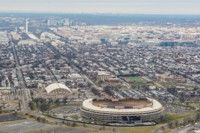
19.01.2017 © Staff Sgt. Patrick Evenson 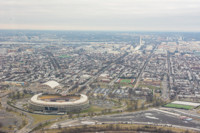
19.01.2017 © Staff Sgt. Patrick Evenson 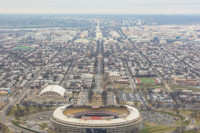
19.01.2017 © Staff Sgt. Patrick Evenson
2015
2013
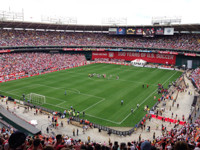
02.06.2013 © boothy443 (CC BY-SA 3.0)
2011
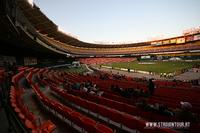
21.04.2011 © Stadiontour.at 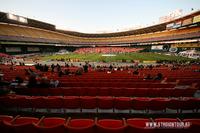
21.04.2011 © Stadiontour.at 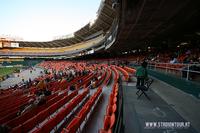
21.04.2011 © Stadiontour.at 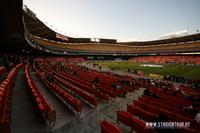
21.04.2011 © Stadiontour.at 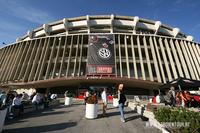
21.04.2011 © Stadiontour.at 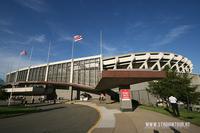
21.04.2011 © Stadiontour.at 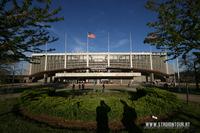
21.04.2011 © Stadiontour.at 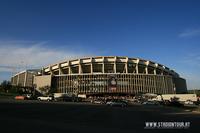
21.04.2011 © Stadiontour.at
2009
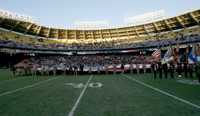
29.12.2009 © David (CC BY 2.0)
2006

06.07.2006 © Rudi Riet (CC BY-SA 2.0)
2005
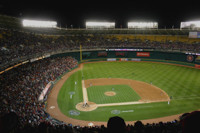
16.04.2005 © David (CC BY 2.0)
1988
Related news
2025
-
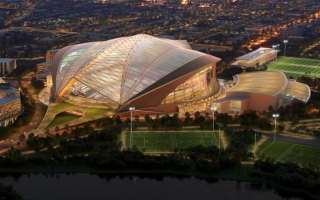
USA: Work on long-awaited Washington stadium project in full swing
The Washington D.C. City Council voted 11-2 in favor of building a new stadium complex on the site of the old RFK Stadium, clearing the way for the Washington Commanders to return from their current Landover facility.
-
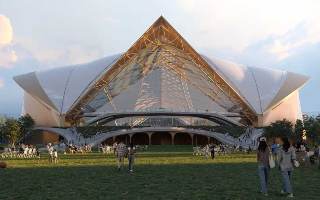
USA: Commanders stadium future in doubt as Washington risks major loss
In early June, reports emerged that the Washington City Council is considering removing the agreement for a new stadium for the Commanders from the District’s budget.
-
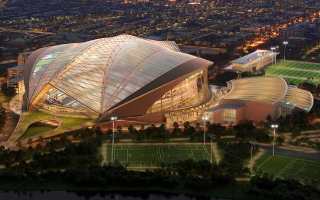
USA: It’s official – the Commanders are returning to Washington!
Washington D.C. Mayor Muriel Bowser and Josh Harris, managing partner of the Washington Commanders, have announced an agreement for the team’s return to the capital and the revitalization of 180 acres surrounding the RFK campus.
-
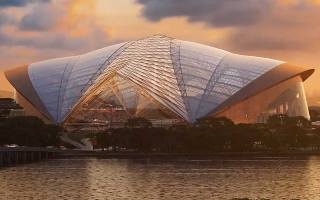
USA: First concept for new RFK Stadium unveiled
Although the RFK Stadium site hasn’t been officially transferred from federal hands to the D.C. government, architect Kyle Murphy has already presented his vision for a potential new Commanders stadium.
-
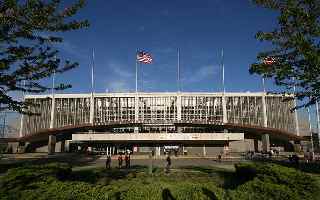
USA: Time to demolish the largest stadium in Washington
Preparations for the demolition of RFK Stadium began on January 13, with full demolition set to begin later this month.
-
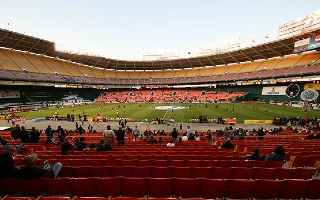
USA: Joe Biden signs bill handing over RFK Stadium to Washington
On January 6, President Joe Biden signed a bill that transfers control of the land housing the old RFK Stadium from the federal government to the city of Washington, marking another step toward the potential return of the Washington Commanders to the nation’s capital.
2024
2020
2018
-

Where will Redskins land after FedEx Field dies?
It's been a bad season in a bad era for the Washington Redskins. And their stadium is, you've guessed correctly, bad as well. FedEx Field will only last until 2027, the team staying there is not part of a legacy plan. Where to, then?
-

Washington D.C.: RFK Stadium revamp begins
The stadium itself will remain intact, at least in the short term. However, the first phase of the precinct's redevelopment is already underway. Will Redskins build their new stadium here?
-

New stadium: Audi Field opened with a glitch
While D.C. United were celebrating the dream-come-true with #UnitedAtHome hashtag, hundreds of fans were chanting in protest outside, as their groups have been excluded. Not exactly the right mood for such a festive occasion.
2017
-

Washington, D.C.: RFK Stadium sees end of MLS football
On October 22 the Robert F. Kennedy Memorial Stadium saw its very last football game. After Redskins, now it's time for DC United to find a new home.
-

Washington D.C.: Scheduling games at Audi Field is a challenge
As construction continues on schedule, D.C. United are still unsure about their home-game schedule for the 2018 MLS season. Audi Field won't be ready by mid-season so they might have to use an alternative venue.
-

Washington DC: How the Audi Stadium can improve DC United's form in MLS
With 75% of MLS now already playing at "soccer specific" stadiums, it's high time for DC United to join the pack. After all, they helped create the league and have a poor record at RFK Stadium this season.
-

Washington: D.C. United get final permit
As early work is already ongoing on the site of Audi Field, D.C. United managed to secure the final paperwork needed to go on with their new stadium. A BlackAndRedUnited.com report.
-

Washington, DC: No room for RFK Stadium in the future
The fate of Washington Redskins is still unclear but it seems there won’t be any stadium on the site of current RFK Stadium in the long run.
2016
-

Washington: Contractor selected for DC United stadium
D.C. United has awarded a $150 million contract to Turner Construction Co. to build its Buzzard Point soccer stadium, an important step toward the Major League Soccer team's goal of starting the 2018 season in the Capitol Riverfront.
-

Washington DC: Clearing begins for DC United Stadium
Washington mayor herself began the clearing of Buzzard Point, where the new DC United Stadium will be built in early 2018. Actual groundbreaking to follow within weeks.
-

Washington DC: Here’s the future of RFK Stadium
It will be 55 years old this October and there’s not much life left for RFK Stadium. The building will be demolished and here are two options of how the entire area of Washington DC can be reinvented.
 StadiumDB
StadiumDB